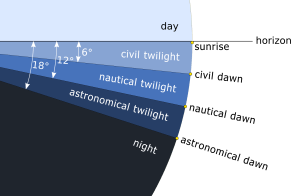What time is Dawn?
Location: City of London, England, United Kingdom
Latitude: 51.5156177
Longitude: -0.0919983
Time Zone: GMT+00:00
Time Zone ID: Europe/London
Click to Show/Hide the Map
What time is Dawn?
Today's date: Thu, December 11, 2025
Time now:
Dawn time today: 07:17 am
Dawn time tomorrow: 07:18 am
• What is Civil Dawn? Civil Dawn is the moment when the geometric center of the Sun is 6 degrees below the horizon in the morning (Morning nautical twilight ends, morning civil twilight starts).
• Morning Civil Twilight occurs when the Sun is less than 6 degrees below the horizon, it begins when the Sun is 6 degrees below the horizon and ends at sunrise.

Dawn time in City of London, England, United Kingdom
| Dec 2025 | Day | Dawn | Sunrise |
|---|---|---|---|
| Dec 10, 2025 | Wednesday | 07:16 am | 07:56 am |
| Dec 11, 2025 | Thursday | 07:17 am | 07:57 am |
| Dec 12, 2025 | Friday | 07:18 am | 07:58 am |
| Dec 13, 2025 | Saturday | 07:19 am | 07:59 am |
| Dec 14, 2025 | Sunday | 07:20 am | 08:00 am |
| Dec 15, 2025 | Monday | 07:20 am | 08:01 am |
| Dec 16, 2025 | Tuesday | 07:21 am | 08:01 am |
| Dec 17, 2025 | Wednesday | 07:22 am | 08:02 am |
| Dec 18, 2025 | Thursday | 07:22 am | 08:03 am |
| Dec 19, 2025 | Friday | 07:23 am | 08:03 am |
| Dec 20, 2025 | Saturday | 07:24 am | 08:04 am |
| Dec 21, 2025 | Sunday | 07:24 am | 08:05 am |
| Dec 22, 2025 | Monday | 07:25 am | 08:05 am |
| Dec 23, 2025 | Tuesday | 07:25 am | 08:05 am |
| Dec 24, 2025 | Wednesday | 07:26 am | 08:06 am |
| Dec 25, 2025 | Thursday | 07:26 am | 08:06 am |
| Dec 26, 2025 | Friday | 07:26 am | 08:06 am |
| Dec 27, 2025 | Saturday | 07:26 am | 08:07 am |
| Dec 28, 2025 | Sunday | 07:27 am | 08:07 am |
| Dec 29, 2025 | Monday | 07:27 am | 08:07 am |
| Dec 30, 2025 | Tuesday | 07:27 am | 08:07 am |
| Dec 31, 2025 | Wednesday | 07:27 am | 08:07 am |
| Jan 2026 | Day | Dawn | Sunrise |
| Jan 1, 2026 | Thursday | 07:27 am | 08:07 am |
| Jan 2, 2026 | Friday | 07:27 am | 08:07 am |
| Jan 3, 2026 | Saturday | 07:27 am | 08:07 am |
| Jan 4, 2026 | Sunday | 07:27 am | 08:06 am |
| Jan 5, 2026 | Monday | 07:26 am | 08:06 am |
| Jan 6, 2026 | Tuesday | 07:26 am | 08:06 am |
| Jan 7, 2026 | Wednesday | 07:26 am | 08:05 am |
| Jan 8, 2026 | Thursday | 07:25 am | 08:05 am |
| Jan 9, 2026 | Friday | 07:25 am | 08:04 am |